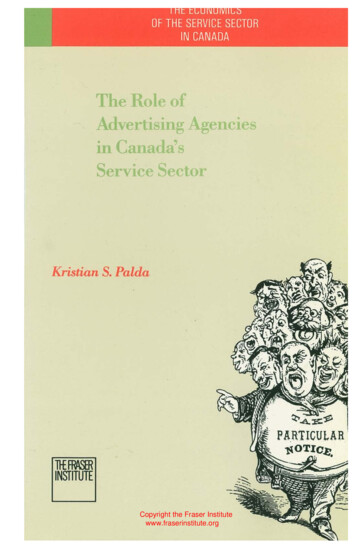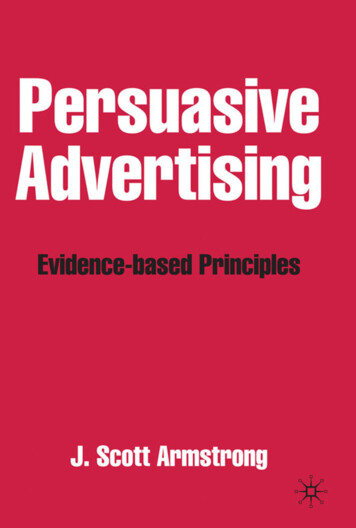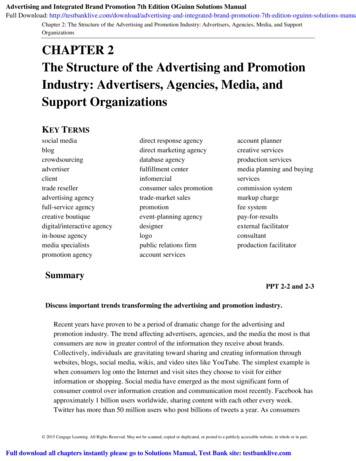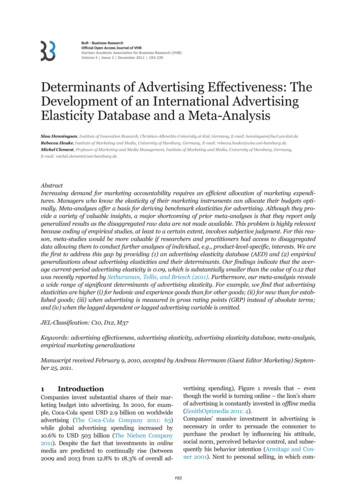
Transcription
,,OF THE SERVICE SECTORIN CANADAThe Role ofAdverti::.ing Agenciesin Canada' Service ectorKristian S. Paldallf INSTITUTECopyright the Fraser Institutewww.fraserinstitute.org
The Role ofAdvertising Agenciesin Canada'sService SectorCopyright the Fraser Institutewww.fraserinstitute.org
THE ECONOMICSOF THE SERVICE SECTORIN CANADASeries Editors:Herbert G. GrubelMichael A. WalkerCopyright the Fraser Institutewww.fraserinstitute.org
The Role ofAdvertising Agenciesin Canada'sService SectorKristian S. PaldallfFRASERINSTITUTECopyright the Fraser Institutewww.fraserinstitute.org
This study is part of a general programme of research into the services sector made possibleby a contribution from the Department of Regional Industrial Expansion, Government ofCanada.The author of this book has worked independently and opinions expressed by him, therefore,are his own and do not necessarily reflect the opinions of the members or the Trustees of TheFraser Institute.Canadian Cataloguing in Publication DataPalda, Kristian S., 1928The role of advertising agencies in Canada'sservice sector(The Economics of the service sector inCanada, ISSN 0835-4227)Includes bibliographical references.ISBN 0-88975-109-91. Advertising agencies - Canada. I. FraserInstitute (Vancouver, B.C.). II. Title.III. Series.HF6182.C2P34 1988659.1 '125'0971C88-091233-2Copyright 1988 by The Fraser Institute. All rights reserved. No part ofthis book may be reproduced in any manner whatsoever without writtenpermission except in the case of brief quotations embodied in critical articles and reviews.Printed in Singapore.Copyright the Fraser Institutewww.fraserinstitute.org
CONTENTSPreface and Summary / xiAcknowledgements / xiiiIntroduction / xvAbout the Author / xviiiCHAPTERlA DESCRIPTION OF THE INDUSTRY / 1Definitions Used in This Study / 1Industry / 1Services / 2Characteristics of Services Provided /2General Considerations / 2The First Perspective /3The Second Perspective /6Specific Descriptions / 7Evolution of Advertising Service Characteristics / 9Main Consumers of SIC 774 Services / 11Characteristics of Employees / 15Importance of Research and Technology /16Regulation / 17Perceived Needfor Regulation of Advertising /17Canada's Regulatory Set-Up / 19Industrial Associations / 25Treatment in Government Statistics /28Regional Differences in Production and Sales in Canada / 29Importance of Imports and Exports / 30Notes / 31Copyright the Fraser Institutewww.fraserinstitute.org
vi ContentsCHAPTER 2INDUSTRIAL ORGANIZATION ANDINTERNATIONAL POSITION / 35Industrial Organization Characteristics / 35Legal Forms of Ownership /35Size Distribution of Firms / 35The Whole of SIC 774 / 35Advertising Agencies /35Advertisers / 39Internal Advertising Agency Organization /39Degree of Foreign Ownership and Influence /41The Industry in the World Economy /41Current Aspects / 41Future Prospects / 43Notes/45CHAPTER 3INDUSTRY OUTPUT / 47Advertising Expenditures in Canada /47Revenues of SIC 774 Enterprises / 50Revenues of Advertising Agencies / 54Exports and Imports / 57Notes/58CHAPTER 4INDUSTRY EMPLOYMENT AND PRODUCTIVITY / 59Expenditures on Inputs Into the Industry's Output/59Capital Inputs / 59Labour Expenses /59Input/Output /59Size and Characteristics of the Labour Force Employed / 62Labour Productivity /67Notes/71Copyright the Fraser Institutewww.fraserinstitute.org
Contents viiCHAPTERSSOURCES OF CHANGING DEMANDIN THE INDUSTRY / 73General Considerations and Formal Models /73Informal Analysis of Potential Changes in Demand / 76The A/GNP Ratio / 76The Advertising-Promotion Mix / 76Other Developments / 77Conclusions / 77Notes/79CHAPTER 6WELFARE AND INCOME DISTRmUTION EFFECTS /81Employment Growth and Share in Total / 81The Bimodality Hypothesis / 81Value Added to the Economy /82Riskiness of the Business / 82Taxes Paid by the Industry / 85Notes/86CHAPTER 7MAJOR ISSUES FACING THE INDUSTRY / 87Shift Away from Media Advertising / 87Mergers and Globalization / 87Technological Change / 89The Remuneration System /90Regulation and Taxation / 91Freer Trade with the United States / 91Concluding Remarks / 92Notes/95Copyright the Fraser Institutewww.fraserinstitute.org
viti ContfmtsAPPENDIX ACANAVIANCODE OF ADVERTISING STANDARDS / 97APPENDIXBTESTING FOR CAUSALITY BETWEEN AGGREGATEADVERTISING AND CONSUMPTION IN CANADA /103Copyright the Fraser Institutewww.fraserinstitute.org
TABLES AND FIGURESTables1 Internal Costs of Advertising and External Expenditureson Advertising, 1965/32 Media Advertising Expenditures in Selected Industries / 123 The Top 35 Advertisers in 1985/ 134 Selected Statistics Regarding Canadian Federal GovernmentNational Advertising Expenditures /145 Advertising Self-Regulation and Government Regulation / 216 Membership in the Institute of Canadian Advertising, 1985/267 Income, Billings, Employees and Offices of 12 CanadianAdvertising Agencies / 388 1986 U.S. and Non-U.S. Billings and Gross Income ofTop 5 U.S.-based Agencies /429 Advertising and GNP 1971-1986/4810 National and Local Components of Media Net AdvertisingRevenues, 1984/5011 Advertising Services-Revenues / 5112 Net Profit Before Tax and Return on Equity ofIncorporated Advertising Service Businesses (1965-1984) / 5313 Advertising Agencies-Revenue Statistics /5514 Input/Output Table for the Advertising Services Industry / 6015 Various Employment Statistics / 6116 Employment and Male/Female Proportions /6317 Employment and Education, by Sex (1971 and 1981) / 6418 Labour Productivity Indices in SIC 774/6819 Labour Productivity Indices in the Agency Sector / 6920 Growth and Share of Labour Force in Advertising Servicesand in the Economy, 1961-1984/8221 How 136 Canadian Advertisers Compensated Their Agenciesin 1985/91Copyright the Fraser Institutewww.fraserinstitute.org
x ContentsFigures1 Advertising Standards Council Self-Regulatory Procedure / 222 Canadian Advertising Foundation /273 Total Revenue-Regional Distribution AdvertisingServices 1984 /294 Number of Firms by Revenue Size 1982-1984/375 Average Revenue-Advertising Services 1982-1984/376 Organizational Chart of a Typical Advertising Agency /407 Gross Advertising Revenues of Media 1971-1986 /498 Gross Ad Revenue as Percentage of GNP 1971-1986 /499 Advertising Services-Revenues 1965-1984/5110 Net Profit Before Tax as a Percentage of Total Income andROE Before Tax 1965-1984/5311 Total Billings & Gross Revenue from Ad Billings 1972-1977 / 5512 Media Billings to Clients 1972 / 5613 Media Billings to Clients 1977 / 5614 International Receipts & Payments / 5715 Remuneration as Percentage of Total Income 1973-1984 / 6116 Female Share of Labour Force 1961-1981/6317 Share of Labour-University Degree 1971-1981 /6518 Percentage of Females-University Degree 1971-1981/6519 Real Value Added-Advertising Services / 6820 Real Value Added per Employee /6921Gross Advertising Expenditure and PersonalConsumption Expenditure 1952-1986/7422 Personal Expenditures on Services-Proportion ofTotal 1965-1985 /7523 Expenditure in Print Media-Percentage of Total 1965-1985 /7524 GDP of Advertising Services in Current and Constant (1971)Prices 1971-1983/8325 Advertising Services' Share ofGDP 1971-1983/8326 GDP of Services to Business in Constant (1971) Prices 1971-1983/8427 Indirect and Direct Taxes 1973-1984/84A-I The Plan for an Advertising Campaign / 102Copyright the Fraser Institutewww.fraserinstitute.org
PREFACE AND SUMMARYThis study describes and analyses the services-to-business sector which, onbehalf of the advertisers, prepares and places in media just under one-halfof the advertising directed to Canadian buyers. The sector consists quitevisibly of advertising agencies, and of a multitude of supporting businessesabout which there is very little information. Total revenues of the sector areat the 1.5 billion mark; its share of the gross domestic product is in slightdecline.Despite its modest size, the sector's member fIrms playa crucial role indisseminating market information in Canada's economy. That role, its history and its organizational underpinning are described at length. The sectoris intensive in human capital and readily adaptive to technological change.Yet its growth appears to depend on changes in the economy's output andis less dynamic than that of business services in general.Of the several chalh::nges the sector is facing, that of the alleged shift ofadvertisers' funds to sales promotion and that of global standardization ofmultinationals' advertising appear the most prominent. The first challengepresents an opportunity rather than a problem. The second may prove difficult for Canadian-owned agencies that service foreign multinationals.The statistical information about the sector used to be (until 1977) muchbetter but will improve again when the results of the yearly surveys startedby Statistics Canada in 1985 become available. A co-operation between thetrade associations of advertisers, media, and agencies with StatisticsCanada would easily yield a valuable yearly compendium of informationon this and allied sectors.,Copyright the Fraser Institutewww.fraserinstitute.org
Copyright the Fraser Institutewww.fraserinstitute.org
ACKNOWLEDGEMENTSI wish to express my gratitude to those who pointed me to data sources,provided and shared information, and gave excellent advice. Ms. AnnaAnsmits, director of the services division of Statistics Canada, and herassociates were most helpful with official data. Mr. Geoffrey Mitchell,manager of Maclean Hunter's research bureau, discussed other datasources. Mr. John Foss, president of the Association of CanadianAdvertisers, and Mr. Keith McKerracher, president of the Institute ofCanadian Advertising, made available some trade association statistics andmuch valuable substantive information. Mr. Jack Milne, former managingdirector of the Institute of Canadian Advertising, discussed the manuscriptand made many valuable suggestions. Dr. Robert Oliver, former presidentof the Advertising Standards Council and one of its founding fathers,directed my attention to the literature on self-regulation. Ms. Grace Kingmade available a brief but well-organized overview of the sector which sheprepared for the Government of Canada. None of these kind helpers should,however, be blamed for the blemishes of this study.The Fraser Institute, in the person of the director of these sectoralstudies, Professor Herbert Grubel, and through the organization of threeworking conferences, was of great assistance. A Queen's undergraduate,Mr. Michael Detlefsen, an M.B.A. student, Brian Lewis, and a Ph.D.student, Eben Otuteye-all of the School of Business-were very capableresearch assistants. Mrs. Helen Chiasson managed the word processoradmirably. To all of these, my thanks.Copyright the Fraser Institutewww.fraserinstitute.org
Copyright the Fraser Institutewww.fraserinstitute.org
INTRODUCTIONThe objective of this study is to contribute to the body of knowledge aboutthe structure, evolution and dynamics of the service sector of the Canadianeconomy. This study is but one in a series commissioned by the Fraser Institute on behalf of the Department of Regional Industrial Expansion. Itdeals with a rather tiny slice of Canada's economic output, on the order of0.15 percent of GDP in 1984. This output was embodied in the activities ofadvertising agencies and their subcontractors (sector SIC 774). It consistedof the creation and placement of about 45 percent of the nation's advertisements, worth about 2.75 billion of media space and time, or over 0.6 percent of GNP in that year. The social, cultural and economic impact of thesector's labour is of course out of proportion to its limited output significance.Advertising is one of the chief means of information provision to buyersand so a precious lubricant of the wheels of the economy. Being highlyvisible and often loud, it accentuates many of our society's mass culturaltraits and tends to impose them even upon the unwilling. Since it is themost perceptible of business activities, it frequently gives rise to controversy and anti-business clamour. Indeed, the small volume (in economicterms) of advertising preparatory activity and the disproportionate effectsthe results generate bring to mind another service activity with even greaterconsequences-the debating and passing of legislation.This study, however, sticks strictly to the analytical description of theagency-plus-subcontractor sector. It shuns reflections of grander design,such as whether advertising is largely persuasive rather than informative,what its impact on competition may be, and so on. For this avoidance thereis an excellent reason. In order to view advertising from the point of viewof the "big think," one would have to acknowledge that its delivery beforebuyers is the joint responsibility of advertisers, agencies and media. Butthese three joint venturers constitute neither a homogeneous industrial sector nor are they all service producing enterprises. Together they thereforeexceed the scope of the service sector inquiry mandate.The major part of the monograph is given over to as thorough a description of the sector as possible. Not surprisingly, the chief obstacle to this endeavour was the absence of official statistics. It should, however, bepointed out that up to 1977 yearly surveys of advertising agencies by Statistics Canada yielded a reasonably rich source of data. (In 1965 theDominion Bureau of Statistics published a rather magnificent compilationof advertising expenditures in Canada.) From 1985 on, too late for thisCopyright the Fraser Institutewww.fraserinstitute.org
xvi Introductionstudy, a fairly thorough yearly survey of the sector has been reinstituted.Where possible, therefore, official infonnation was supplemented byrecourse to trade association and private source infonnation. However,there are neither government statistics nor trade associations-and so notrade infonnation-dealing with the numerous small and medium-sizedenterprises that supply the advertising agencies and that constitute the 7742-3-9 components of the sector.The advertising services to business industry was found to be entrepreneurial, human capital intensive, open to technological development,and growing moderately in productivity. However, it did not grow in outputnearly as fast as the total category it is embedded in, services to business orSIC 77. Indeed, its tiny share of total GDP shrank somewhat. The rosy official statistics on the profitability of the sector are in some contradiction toinformed private and press opinion about the health of the larger advertising agencies. Since none of these has stock traded publicly, no verificationof this issue is possible.The challenges to the members of this industry are discussed in the lastpart of the paper. The two most obvious ones are the alleged shift of theadvertisers' funds away from advertising to sales promotion and the socalled globalization of marketing and so of advertising. This may beresponsible for the merger movement observed among the agencies. Whilethere is consensus in trade circles on the shift to sales promotion, hard andreliable data come in small scraps only. There is no reason why this part ofthe communication dollar could not be handled by the agencies; most of itvery likely is so handled already.The challenge of globalization is a challenge originating with foreignmultinationals which may prefer a standardized advertising campaign to beprepared in New York, London or Tokyo. In that sense, the problem of theCanadian-owned advertising (service) agency is not dissimilar to that ofmany other finns that service foreign multinationals in Canada. We needsome solid data here which could be gathered by the industry itself. Suchdata could throw much needed light on a phenomenon that cannot bejudged a priori as causing a welfare loss to the Canadian economy.Perhaps of equal importance to the analytical description of the 774 sector is the recommendation for filling statistical information gaps. The understanding and acceptance of such a recommendation cannot be divorcedfrom the study of the text which follows. Let it merely be mentioned herethat Statistics Canada will now provide indispensable information thatcould be fruitfully merged with private trade association data. This wouldoffer the business and academic students of the sector a single yearly andvaluable compendium.Copyright the Fraser Institutewww.fraserinstitute.org
ABOUT THE AUTHORKristian Palda is professor of business at Queen's University, Kingston,Ontario. Born in Prague, Czechoslovakia in 1928, he completed his undergraduate education at Queen's University in 1956 and obtained his M.B.A.and Ph.D. from the Graduate School of Business of the University ofChicago, where he was the recipient of the 1963 Ford Foundation doctoraldissertation prize.Professor Palda taught business and economics at the Ecole des HautesEtudes Commerciales in Montreal from 1958 to 1962, when he was appointed assistant and then associate professor at the State University ofNew York at Buffalo. In 1965 he went to Claremont Graduate School,Claremont, California where he was professor of business economics until1970. He was appointed to his present position at Queen's University in1970. He held visiting appointments and has lectured widely in NorthAmerica and Europe, especially in French-language areas.Professor Palda's research interests, always coloured by economic analysis,have been devoted to two fields: the examination of advertising effects incommercial and political markets, and issues in technological innovation.He has published six books touching on these areas, the latest two beingThe Science Council's Weakest Link and Industrial Innovation with theFraser Institute. His most recent articles on campaign spending and technological innovation appeared in Canadian Public Policy and ResearchPolicy. respectively. In 1987 Professor Palda won a Queen's Universityprize for excellence in research.Copyright the Fraser Institutewww.fraserinstitute.org
Copyright the Fraser Institutewww.fraserinstitute.org
CHAPTERlA DESCRIPTION OF THE INDUSTRYDefinitions Used in This StudyIndustryIn this study we examine the sector "Advertising Services," SIC 774(before 1980: SIC 862). Recently completed surveys by Statistics Canada1estimate the size of the sector at 1.56 billion in total revenue for 1984.Another source indicates that the industry employed about 18,125employees? Private communication from Statistics Canada puts the shareof this revenue accounted for by the four-digit component 7741, "advertising agencies," at approximately 70 percent.3Agencies are defined as establishments primarily engaged in creatingand/or placing advertising with publications, radio and television and othermedia such as outdoor. While agencies are the single largest component ofthe three-digit sector, little government information is available about themsince annual surveys of their activities were stopped in 1977. No censuswas taken of the services industry in 1981.The next four-digit constituent of this industry is "media representatives"(SIC 7742), establishments primarily engaged in selling time and space forvarious media. SIC 7743, "outdoor display and billboard advertising," represents establishments primarily engaged in the rental of space on signs,displays and billboards. Those primarily engaged in manufacturing neonsigns, non-electric signs and other sign materials are classified andreasonably well documented under the manufacturing sector 3971, "signand display industry" (StatsCan annual catalog 47-209; more about this iIichapter 2.) Finally, "other advertising services" (SIC 7749) comprise establishments engaged in advertising services not elsewhere classified, such ascommercial art services, copy writing services, direct mail advertisingservices, handbill advertising services, novelty promotion services,research services-advertising, sample distribution services, sign paintingservices.Copyright the Fraser Institutewww.fraserinstitute.org
2 A Description of the IndustrySome of these may be a figment of the imagination of SIC classifiers inthe sense that while such services are no doubt provided they are not"primarily" provided. For instance, public relations is not listed. It is afunction more often than not supplied by advertising agencies. Its non-appearance under 774 may be due to the fact that it is not, typically, theagency's primary function.It is worthwhile repeating that no separate report is available on the nonadvertising agency parts of this service sector, that is on 7742, 7743 and7749, and that the advertising agency series ends in 1977.ServicesAdvertising services, SIC 774, are a part of the major group 77, businessservice industries, which comprise "establishments primarily engaged inproviding services more to the business community than to the generalpublic." We shall consider for the purposes at hand that the definition ofbusiness community includes the governmental as well as non-profit sectors such as charities. By definition, then, classified ads (an importantproportion, up to one-quarter of newspaper advertising) do not benefit fromthe commercial advice of the 774 sector.Characteristics of Services ProvidedGeneral ConsiderationsAdvertising services, in the broadest terms, form an important constituentpart of the marketing activities of the firms and institutions that advertiseboth to industrial and consumer markets. Here we have in mind serviceswhich are provided to the advertisers from the outside by advertising agencies and other supporting firms.Advertisers do not wholly rely on agencies and other outside suppliers inpreparing their final advertising "output." Their marketing function devotessome time to this task. We have interesting figures to document the costsincurred from a 1965 Dominion Bureau of Statistics survey of 10,000 advertisers. As table 1 indicates, in that year these advertisers spent 764 million, of which 83 million or about 12 percent was expended in-house.It should also be pointed out that much of retail and small business advertising is prepared with the normally un-invoiced help of the mediawhich, in such cases, plays the role of advertising counsel. A private communication from a major Canadian newspaper operation indicated that in1985 the cost of selling advertising (which would in part cover the "free"advice to advertisers) as a percentage of total advertising revenue was 7.5Copyright the Fraser Institutewww.fraserinstitute.org
A Description of the Industry 3Table 1Internal Costs of Advertising and External Expenditureson Advertising, 1965(in thousands of dol1ars)ManufacturingRetail tradeWholesale 10310.513.417.612.441.521.3Transportation and otherpublic utilitiesTelecommunicationsHotels and restaurantsOthe!" services, includingfinancial and ,78610.8TOTALS83,166680,965Source:(1) aspercentof (2)12.2Advertising Expenditures in Canada, 1965, Dominion Bureau ofStatistics, 63-216 Annual, tables 8 and 9.Note:Based on a survey of 10,000 advertisers.percent. Production costs associated with the layout of the newspaper forthe advertising portion were 4.8 percent of that advertising revenue in thatyear.What are the characteristics of the services provided by this industry toits customers, the advertisers? Two perspectives can be taken in providingthe necessary description.The First PerspectiveThis section looks at the marketing activities of the advertiser and considersthe advertising agency's assistance in supporting them. Most profit-orientedfirms of a certain size and some non-profit organizations as well have customer publics which it would be uneconomical to reach by means of direct,employee-to-customer contact. Indeed, one of the determinants of advertising intensity (the ad/sales ratio) is the number of final users of the productCopyright the Fraser Institutewww.fraserinstitute.org
4 A Description o/the Industryor service which the advertiser sells. 4 The infonnation function, responsiblefor letting the ultimateS customer know about the existence and quality ofthe brand, plays a major role in expanding and sustaining the demand forthe brand.One can indeed represent demand for a finn's brand as:qi f (Pi, Xi, Si, di ;Pr, xr, Sr, dr ; El, . ,En)whereqi the quantity of brand i sold during a given periodPi i' s unit priceXi i' s index of qualitySi i's advertising expendituresdi i's personal selling expendituresr a subscript standing for the activities of all rivalsE environmental influences, such as income.Over the last quarter-century this representation of demand for a productbrand has become standard and serves as the basic departure point for itseconometric estimation and for the profit-oriented optimization of thelevels of the right-hand, i-indexed variables which are collectively known. 6· mIX.as th e mark etmgThe advertiser's decision as to the optimal level of the advertisingbudget is necessarily conditioned by the market's response to advertising,given the levels of the other mix variables and those of its rivals, and by theskill or efficiency with which infonnation about the brand is fonnulatedand disseminated. The advertising agency is the specialist outside consultant on which the advertiser relies to create the copy (messages) and to placeit into the mass media selected on its advice. The continuous interplay ofpast effectiveness, current advertising goals and the choice of copy andmedia to achieve them leads to the determination of the size of the advertising budget and so to the chosen level of the advertising ingredient in thetotal marketing mix.The advertising agency, under best practice, participates in all the crucialsteps of the brand's marketing planning. Its advice is determinant in thepreparation of the brand's advertising strategy, typically translated into aformal advertising plan, an example of which is given in appendix figureA-I.In the case of smaller and medium-sized advertisers, the agency oftensupplies general and specific marketing research expertise, usually at extracost beyond the customary 15 percent fee on media billings. This may beCopyright the Fraser Institutewww.fraserinstitute.org
JA Description of the Industry 5needed for efficient preparation of the marketing plan and its component,the advertising plan.While the advertising agency's focus of attention is on the services itprovides to the advertiser, it acts, of necessity, as a co-ordinator of mediaspace and time offerings. It is also purchaser and production co-ordinator ofa rich array of service and supply companies to itself. This second perspective on the activities of advertising agencies needs little elaboration; advertising revenues to print and broadcast media are currently at the 7 billionannual level. Yet the co-ordination of subcontractors such as commercialartists, photographers, and video and film production fIrms necessary forthe preparation of the finished ad or commercial is also of signifIcance. Theproduction cost of a 30-second television commercial can easily reach 100,000 or more.Officially, advertising has been defined by the Institute of Canadian Advertising (the national association of advertising agencies) as "the paid useof mass communications." The American Marketing Association's definition is wider, "any paid form of non-personal presentation and promotionof ideas, goods or services by an identified sponsor." Note the adjectives"paid" and "non-personal." The first excludes publicity, the output of thepublic relations function. The second goes beyond mass media to suchvehicles as direct mail.According to one of the business community's elder statesmen RobertOliver, people in the business community regard advertising in several different ways: as a communications tool that helps open up new markets orexpand existing ones; as a means of introducing or explaining new productsor services; and finally, because of its very nature, as a catalyst in theeconomy?Do these various definitions and views of advertising help to provide uswith a better insight into the fundamental nature of the services furnishedby the principal "doers" and co-ordinators, the agencies? In my opinionthey do so only indirectly, by insisting overwhelmingly on the communications aspect of advertising.Yes, advertising does communicate or transmit messages from seller topotential buyer. Presumably, these messages contain useful informationthat may be relevant to the buyer's choice. And the agency, with its subcontractors, plays a central facilitating part in this process. But we shouldgo further into the analysis of this facilitating process to understand the essential nature of the service provided by the agency. For this we shallemploy the conceptual scheme recently proposed by Melvin. 8Copyright the Fraser Institutewww.fraserinstitute.org
6 A Description of the IndustryThe Second PerspectiveMelvin suggests that the typical production-consumption situation is one inwhich the two are separated by distance and time. The problem is then toconvert or transform the output of the production process, defined as Xp,into a commodity that can provide utility for the consumer, defined asXc.9 A class of services, designated as intermediation services, arisesnaturally to overcome the distance and time constraints and provides theservice transformation function, S:Xc S(Xp, Kg, !.g, Mg)where the other inputs to this transformation process are various kinds ofcapital, labour and other intermediate inputs.The most obvious kinds of intermediation services that come to mind aretransportation and storage, the first overcoming the constraint of distance,the second the obstacle of time difference. They both rely on capital equipment, labour and other i
3 Total Revenue-Regional Distribution Advertising Services 1984 /29 4 Number of Firms by Revenue Size 1982-1984/37 5 Average Revenue-Advertising Services 1982-1984/37 6 Organizational Chart of a Typical Advertising Agency /40 7 Gross Advertising Revenues of Media 1971-1986 /49 8 Gross Ad Revenue as Percentage of GNP 1971-1986 /49










